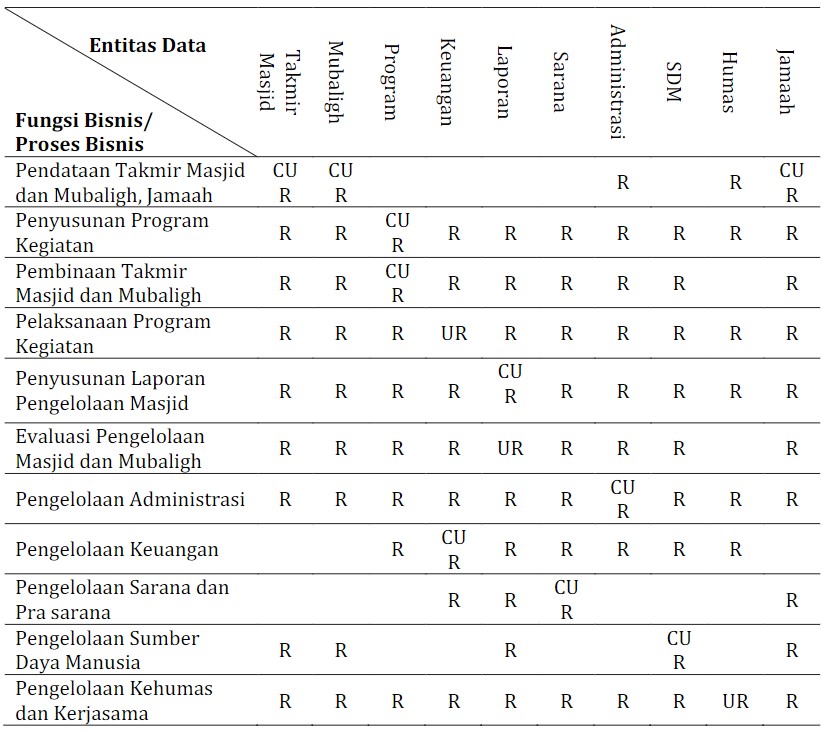Enterprise Architecture Planning untuk Pengelolaan Masjid Muhammadiyah
DOI:
https://doi.org/10.12928/mf.v2i2.2033Keywords:
Enterprise Architecture, Enterprise Architecture Planning, SI/TI, Masjid, MuhammadiyahAbstract
Majelis Tabligh merupakan unsur pembantu pimpinan yang ditunjuk sebagai penanggungjawab lapangan dalam pengelolaan masjid Muhammadiyah. Sampai tulisan ini hadir, data-data berkait pengelolaan masjid masih belum ada, seperti jumlah masjid se-DIY, kondisi masjid, pengelolaan jamaah, pengelolaan keuangan masjid, dan lainnya. Pengawasan terhadap masjid-masjid Muhammadiyah juga masih belum bisa dilakukan, maka perlu dukungan sistem informasi/teknologi informasi (SI/TI) yang terintegrasi. Enterprise Architecture adalah gambaran hubungan logis yang terintegrasi antara visi misi, proses bisnis, system informasi, dan infrastruktur organisasi. Enterprise Architecture Planning (EAP) merupakan suatu metode atau kerangka acuan untuk membangun suatu arsitektur informasi yang mengacu pada tujuan atau kebutuhan bisnis organisasi yaitu arsitektur bisnis, arsitektur data, arsitektur aplikasi, arsitektur teknologi. Pada penelitian ini menghasilkan suatu arsitektur bisnis yang teridentifikasi berupa area fungsi, fungsi bisnis, dan proses bisnis Majelis Tabligh. Arsitektur data berupa 10 entitas data. Arsitektur aplikasi berupa 18 aplikasi. Arsitektur Teknologi yang teridentifikasi salahsatunya menggunakan platform web dan Mobile. Selain itu, didapatkan juga portofolio aplikasi dalam bentuk Mc Farlan Grid.
The Majelis Tabligh is an auxiliary element to the leadership who is appointed to be in charge of the field in the management of the Muhammadiyah mosque. Until now, there are still no data related to mosque management, such as the number of mosques in Yogyakarta, the condition of mosques, management of congregations, mosque financial management, and others. Supervision of Muhammadiyah mosques is still not possible, so it is necessary to support an information system/information technology (IS / IT) system. Enterprise Architecture is a description of the integrated logical relationship between the vision and mission, business processes, information systems, and organizational infrastructure. Enterprise Architecture Planning (EAP) is a method or frame of reference for building an information architecture that refers to the goals or business needs of the organization, namely business architecture, data architecture, application architecture, technology architecture. This research resulted in an identified business architecture in the form of function areas, business functions, and the Majelis Tabligh business process. The data architecture consists of 10 data entities. The application architecture is in the form of 18 applications. One of the identified technology architectures uses web and mobile platforms. In addition, you can also get a portfolio of applications in the form of the Mc Farlan Grid.
References
S. Sochimin, "Manajemen Keuangan Masjid Berbasis Pemberdayaan Ekonomi Umat," El-jizya J. Ekon. Islam, vol. 4, no. 1, pp. 119-150, 2017.
Suara Muhammadiyah, "Majelis Tabligh Gelar Lokakarya Sistem Tata Kelola Masjid Muhammadiyah," Suara Muhammadiyah, Yogyakarta, 25-May-2017.
Nurhidayat Muh Said, "Manajemen Masjid ( Studi Pengelolaan Masjid Agung Al-Azhar Jakarta )," Tabligh, pp. 84-96, 2016.
Pimpinan Pusat Muhammadiyah, Tanfidz Keputusan Muktamar Muhammadiyah Ke-47. Yogyakarta: Pimpinan Pusat Muhammadiyah, 2015.
K. Surendro, Pengembangan Rencana Induk Sistem Informasi. Bandung: Informatika, 2009.
J. Ward and J. Peppard, Strategic planning for an information system, 3rd ed. Chichester West Sussex, England: John Wiley & Son, Ltd, 2002.
E. Ismanto and N. Effendi, "Enterprise Architecture Planning Sistem Informasi Perguruan Enterprise Architecture Planning Sistem Informasi Perguruan Tinggi Dengan Menggunakan Togaf," Pros. 2th Celscitech-UMRI 2017, vol. 2-Sep 2017, no. September 2017, pp. 14-23, 2017.
N. Hentika, "Meningkatkan Fungsi Masjid Melalui Reformasi Administrasi (Studi Pada Masjid Al Falah Surabaya)," J. Adm. Publik Mhs. Univ. Brawijaya, vol. 2, no. 2, pp. 305-311, 2014.
J. Fahana and A. Azhari, "TOGAF for designing the enterprise architecture of LAZISMU," Bull. Soc. Informatics Theory Appl., vol. 2, no. 2, pp. 58-64, 2018.
D. N. Murti, Y. A. Prasetyo, and A. A. N. Fajrillah, "Perancangan Enterprise Architecture Pada Fungsi Sumber Daya Manusia (SDM) Di Universitas Telkom Menggunakan Togaf ADM," J. Rekayasa Sist. Ind., vol. 4, no. 01, p. 47, 2017.
S. H. Hudi Kusuma Bharata, HS Sulistyowati, "Enterprise Architecture Planning Sistem Informasi STMIK Bani Saleh Mengunakan Framework Zachmann," J. Gerbang, vol. 8, no. 1, pp. 80-88, 2018.
T. Aryo, S. Musthofa, and G. Wang, "Perencanaan Sistem Informasi untuk Mendukung Analisis Pemasaran menggunakan Metode EAP pada PT . Cherokendo Benua Wisata," vol. 1, no. 1, pp. 1-9, 2019.
G. Aristi and Ruuhwan, "Perancangan Arsitektur Teknologi Informasi dengan Pendekatan Enterprise Architecture Planning Pada Balai Kemetrologian Disperindag Jawa Barat Design Architecture Of Information Technology with Enterprise Architecture Planning at Balai Kemetrologian Disper," in Jurnal UNIKOM, 2017, vol. 2, no. 1.
Majelis Tabligh dan Dakwah Khusus PWM D.I. Yogyakarta, Pembinaan Masjid Muhammadiyah. Yogyakarta: Majelis Tabligh dan Dakwah Khusus PWM D.I. Yogyakarta, 2005.

Downloads
Published
Issue
Section
License
Copyright (c) 2020 Jefree Fahana, Rusydi Umar

This work is licensed under a Creative Commons Attribution-ShareAlike 4.0 International License.
Start from 2019 issues, authors who publish with JURNAL MOBILE AND FORENSICS agree to the following terms:
- Authors retain copyright and grant the journal right of first publication with the work simultaneously licensed under a Creative Commons Attribution License (CC BY-SA 4.0) that allows others to share the work with an acknowledgment of the work's authorship and initial publication in this journal.
- Authors are able to enter into separate, additional contractual arrangements for the non-exclusive distribution of the journal's published version of the work (e.g., post it to an institutional repository or publish it in a book), with an acknowledgment of its initial publication in this journal.
- Authors are permitted and encouraged to post their work online (e.g., in institutional repositories or on their website) prior to and during the submission process, as it can lead to productive exchanges, as well as earlier and greater citation of published work.

This work is licensed under a Creative Commons Attribution-ShareAlike 4.0 International License.












 Mobile and Forensics (MF)
Mobile and Forensics (MF)